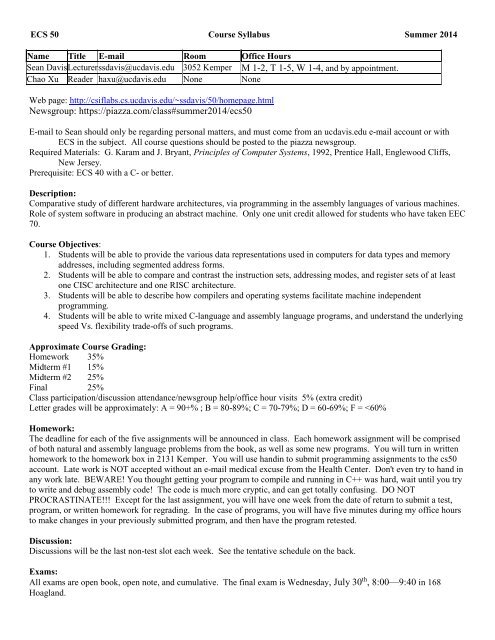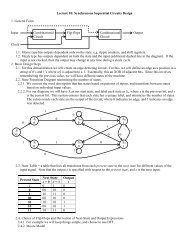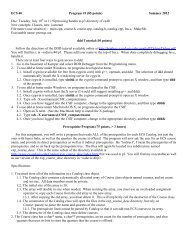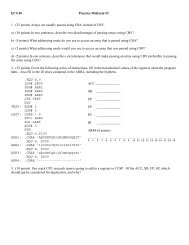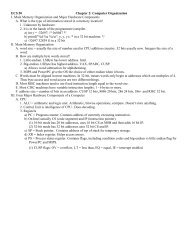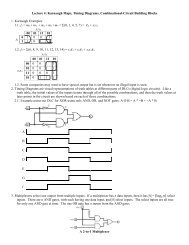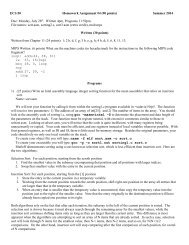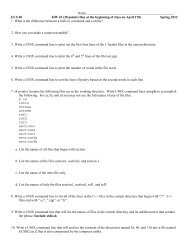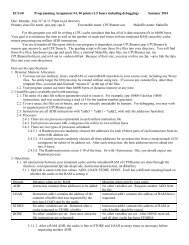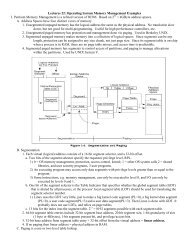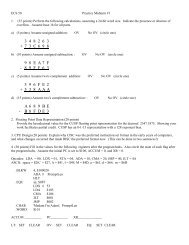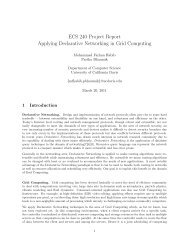ECS 50 Syllabus - CS-CSIF
ECS 50 Syllabus - CS-CSIF
ECS 50 Syllabus - CS-CSIF
- No tags were found...
Create successful ePaper yourself
Turn your PDF publications into a flip-book with our unique Google optimized e-Paper software.
<strong>E<strong>CS</strong></strong> <strong>50</strong> Course <strong>Syllabus</strong> Summer 2014Name Title E-mail Room Office HoursSean Davis Lecturer ssdavis@ucdavis.edu 3052 Kemper M 1-2, T 1-5, W 1-4, and by appointment.Chao Xu Reader haxu@ucdavis.edu None NoneWeb page: http://csiflabs.cs.ucdavis.edu/~ssdavis/<strong>50</strong>/homepage.htmlNewsgroup: https://piazza.com/class#summer2014/ecs<strong>50</strong>E-mail to Sean should only be regarding personal matters, and must come from an ucdavis.edu e-mail account or with<strong>E<strong>CS</strong></strong> in the subject. All course questions should be posted to the piazza newsgroup.Required Materials: G. Karam and J. Bryant, Principles of Computer Systems, 1992, Prentice Hall, Englewood Cliffs,New Jersey.Prerequisite: <strong>E<strong>CS</strong></strong> 40 with a C- or better.Description:Comparative study of different hardware architectures, via programming in the assembly languages of various machines.Role of system software in producing an abstract machine. Only one unit credit allowed for students who have taken EEC70.Course Objectives:1. Students will be able to provide the various data representations used in computers for data types and memoryaddresses, including segmented address forms.2. Students will be able to compare and contrast the instruction sets, addressing modes, and register sets of at leastone CISC architecture and one RISC architecture.3. Students will be able to describe how compilers and operating systems facilitate machine independentprogramming.4. Students will be able to write mixed C-language and assembly language programs, and understand the underlyingspeed Vs. flexibility trade-offs of such programs.Approximate Course Grading:Homework 35%Midterm #1 15%Midterm #2 25%Final 25%Class participation/discussion attendance/newsgroup help/office hour visits 5% (extra credit)Letter grades will be approximately: A = 90+% ; B = 80-89%; C = 70-79%; D = 60-69%; F =
TENTATIVE CLASS OUTLINEDate Reading Topics6/23 AM Chapter 1 Introduction, Data and Their Representations6/23 PM Chapter 2 Computer Organization6/24 Chapter 3 Instruction Set6/25 None Catch-up/ Discussion6/30 AM Chapter 4 The Assembler6/30 PM Chapter 5 Indexed Addressing7/1 Chapter 6 The Stack and Frame Registers7/2 None Catch-up / Discussion7/7 AM Chapters 7 & 8 Character Manipulation, I/O Organization7/7 PM Chapter 8 Interrupts and buffers.7/8 None Catch-up / Discussion7/9 None Midterm #1, Chapters 1-67/14 AM Chapter 11 Intel 8086 Architecture, Memory Access7/14 PM Chapter 11 8086 Procedures, Strings, I/O, Arithmetic7/15 Handout Modern x867/16 None Discussion7/21 AM Handout x86 subroutines7/21 PM Handout RISC vs CISC and Intro to MIPS7/22 None Discussion7/23 None Midterm #2, Chapters 1-87/28 AM Handout MIPS cont’d.7/28 PM Handout MIPS cont’d / History of hardware7/29 None Discussion and review7/30 None Final


